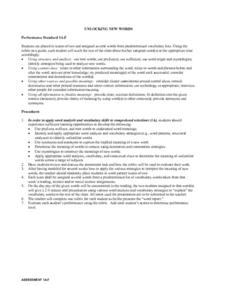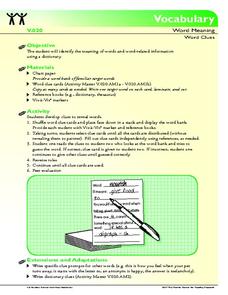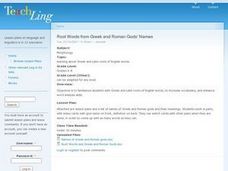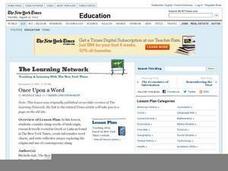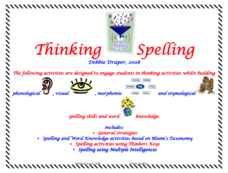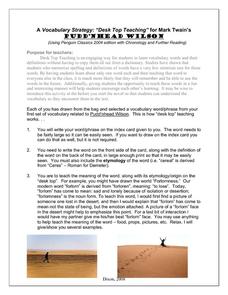Ohio Department of Education
Word Origins
Understanding a word's etymology can really help with decoding and building vocabulary skills. Readers compare and contrast words of similar origins but with different difficulty levels. They focus on prefixes, suffixes, and affixes....
Scholastic
What’s the Good Word? Etymology Project Guidelines
Who named the shapes, or the days of the week? Should words be removed from the dictionary if they're no longer commonly used? Are there too many words in the English language? Language arts students explore these and additional...
Curated OER
Unlocking New Words: Partner Presentations
Following extensive modeling about how to apply word analysis and vocabulary skills to learn new words, partner teams create brief word presentations to teach new vocabulary to the class. Preselect words from upcoming social studies,...
Saddleback College
The Wonder of Words
If your language arts students think etymology isn't relevant to their everyday lives, show them a presentation that will prove them wrong! The slideshow provides explanation about various words, roots, and suffixes that have adapted in...
Florida Center for Reading Research
Vocabulary: Word Meaning, Word Clues
Young learners develop a deeper understanding of target vocabulary. In pairs, pupils independently complete a series of word clue cards, asking them to find information about key terms, including their definitions, synonyms, antonyms,...
Curated OER
Mythological Word Origins
No wonder the ship was called the Titanic. An investigation of Norse, Roman, and Greek Mythology provides insight into mythological characters and corresponding words in the English language. A close look at roots, prefixes, and suffixes...
Curated OER
Latin Roots spect, sta, vert: Synonyms and Antonyms
Advanced readers strengthen their vocabulary repertoires by pairing synonyms and antonyms with six words derived from the Latin roots spect, sta, and vert. A word bank of 24 possibilities provides support (each blank has two appropriate...
Curated OER
Etymology
Learners dissect and build words from parts like prefixes, base words, suffixes, and inflectional endings. Etymology skills help us find the meanings of words by identifying the different parts that constitute them. Class members use...
Curated OER
Root Words from Greek and Roman Gods' Names
Prepare a stack of index cards with a Greek or Roman god's name on one side and their description on the other. Then, use the worksheet attached to brainstorm as many words that contain the root from each card. Pupils also create their...
Florida Center for Reading Research
Vocabulary: Word Meaning, Dictionary Cube
Scholars work together to define words and answer questions using a dictionary cube.
Core Knowledge Foundation
Greek And Latin Root Words
Students examine Greek and Latin root words. They research the history of the English language, solve word games and puzzles, write paragraphs about the impact of Greek and Latin on the English language, and create flip chart study guides.
K12 Reader
Spelling Rule Exceptions for Plural Nouns: Words That End in CH and SH
Have you done the dishes? Or closed the hatches? A practice worksheet invites learners to check 20 words with different endings, and to add either -s or -es to each.
Curated OER
Etymology
Young scholars tie together planet names with Greek mythology. Students browse thru a dictionary to see where exactly these names came from and what significance they have. Young scholars explore the origins of some English words.
Curated OER
Confounding Words
Eleventh graders gain understanding of how words in the English language are formed. They assess their own work for sentence clarity and variety of expression. They increase their comprehension and recall.
Curated OER
Spanish in English
What do the words alligator, armadillo, and cockroach all have in common? Each one is an English word with Spanish origins. Introduce young etymologists to the joys of discovering word origins with a lesson that asks them to create a...
Florida Center for Reading Research
Dictionary Cube
Young scholars investigate new vocabulary words with a fun, collaborative activity. Given a deck of word cards, pairs of students flip over one at a time and independently look up the term in a dictionary. They then take turns rolling a...
Curated OER
Using Word Maps to Expand Vocabulary
Looking for a good instructional activity on dictionary and word definition skills? The instructional activity presented here is for you! In it, learners utilize a worksheet, embedded in the plan, to record a word's...
Curated OER
Etymology Adventures
Students use the internet to research the field of Etymology. Using this information, they create a list of words they were unfamiliar with along with their origin. They complete numerous activities by reading and following directions.
Curated OER
Once Upon a Word
Students explore the derivations and usage of common slang terms. Through internet research and discussion, students consider the Latin and Greek roots of contemporary slang terms. Groups complete an etymology chart documenting their...
Curated OER
Thinking Spelling
An etymology resource is packed with suggestions for activities designed to build phonological, visual, morphemic, and etymological spelling skills.
Curated OER
Pudd'nhead Wilson: Vocabulary Strategy
Invite your pupils to do the teaching when it comes to the vocabulary in Pudd'nhead Wilson. Each individual is assigned one word to research in depth and teach to classmates, one pupil at a time.
Curriculum Corner
Fry Lists
Keep track of your learners' mastered sight words with 11 sets of words. Four columns list the words, as well as three columns for you to mark the date of mastery.
Curated OER
Word Families
This phonics PowerPoint presents sets of word families featuring /a/ and /o/. Each of the words is accompanied by a picture. Students practice sounding out each of the words.
Curated OER
Etymology1 Word Search Puzzle
In this word search worksheet, students locate 30 words given in the word box. Students find the words in a puzzle consisting of 15 rows and 35 columns.


